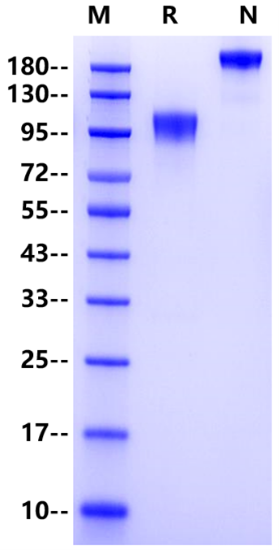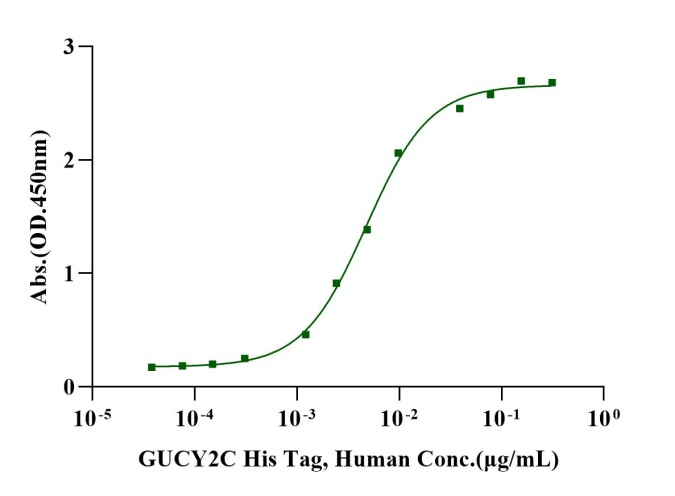Ser24-Gln430, with C-terminal 8*His SQVSQNCHNGSYEISVLMMGNSAFAEPLKNLEDAVNEGLEIVRGRLQNAGLNVTVNATFMYSDGLIHNSGDCRSSTCEGLDLLRKISNAQRMGCVLIGPSCTYSTFQMYLDTELSYPMISAGSFGLSCDYKETLTRLMSPARKLMYFLVNFWKTNDLPFKTYSWSTSYVYKNGTETEDCFWYLNALEASVSYFSHELGFKVVLRQDKEFQDILMDHNRKSNVIIMCGGPEFLYKLKGDRAVAEDIVIILVDLFNDQYFEDNVTAPDYMKNVLVLTLSPGNSLLNSSFSRNLSPTKRDFALAYLNGILLFGHMLKIFLENGENITTPKFAHAFRNLTFEGYDGPVTLDDWGDVDSTMVLLYTSVDTKKYKVLLTYDTHVNKTYPVDMSPTFTWKNSKLPNDITGRGPQGGGSHHHHHHHH
90-115kDa
PBS, pH7.4
Reconstitute at 0.1-1 mg/ml according to the size in ultrapure water after rapid centrifugation.
· 12 months from date of receipt, lyophilized powder stored at -20 to -80℃.
· 3 months, -20 to -80℃ under sterile conditions after reconstitution.
· 1 week, 2 to 8℃ under sterile conditions after reconstitution.
· Please avoid repeated freeze-thaw cycles.
1、Blomain E S. et al. (2016) Guanylyl Cyclase C Hormone Axis at the Intersection of Obesity and Colorectal Cancer. Molecular Pharmacology. 90(3): 199-204.
Guanylyl cyclase C (GUCY2C) is a membrane-bound receptor that produces the second messenger cGMP following activation by its hormone ligands guanylin or uroguanylin, regulating intestinal homeostasis, tumorigenesis, and obesity. In turn, cGMP signaling regulates homeostatic processes in intestine that are canonically disrupted in cancer, including maintenance of DNA integrity and genomic stability. GUCY2C is expressed mostly on the apical surface of intestinal cells but also in the kidney, airway epithelium, perinatal liver, stomach, brain, adrenal glands, and reproductive tissues. Analogous to other rGCs, the primary sequence of GUCY2C reveals a multidomain architecture. Residues 1-23 comprise a putative signal peptide that directs the receptor to the cell surface. This is followed by the ECD (residues 24-430). The intracellular region has a short juxta-membrane domain (residues 455-489) which is followed by a kinase-homology domain (KHD) (residues 490-735), the linker region (residues 736-810), the guanylyl cyclase domain (GCD) (residues 811-1,010), and a C-terminal domain (CTD) (residues 1,011-1,073). Guanylyl cyclase C receptor (GUCY2C) and its hormones, uroguanylin and guanylin, have emerged as a key signaling axis opposing mutations driving intestinal tumorigenesis.


2e5 of transient transfected anti-GUCY2C ScFv CAR-293 cells were stained with 0.1ug GUCY2C His Tag Protein, Human, (Cat. No. UA010185) and unlable respectively (Fig. C and B), and non-transfected 293 cells were used as a control (Fig. A). Alexa Fluor 647 signal was used to evaluate the binding activity. 2e5 of transient transfected anti- GUCY2C ScFv CAR-293 cells were stained with competitor respectively (Fig.D). APC signal was used to evaluate the binding activity.
2e5 of transient transfected anti- GUCY2C ScFv CAR-293 cells were stained with isotype and Whitlow/218 Linker-Alexa Fluor® 488 (Fig. E and F). Alexa Fluor® 488 signal was used to evaluate the binding activity.


Immobilized Anti-Human GUCY2C Monoclonal Antibody at 2μg/mL (100μL/well) can bind GUCY2C His Tag, Human (Cat. No. UA010185) with EC50 of 4.26-5.38ng/ml.